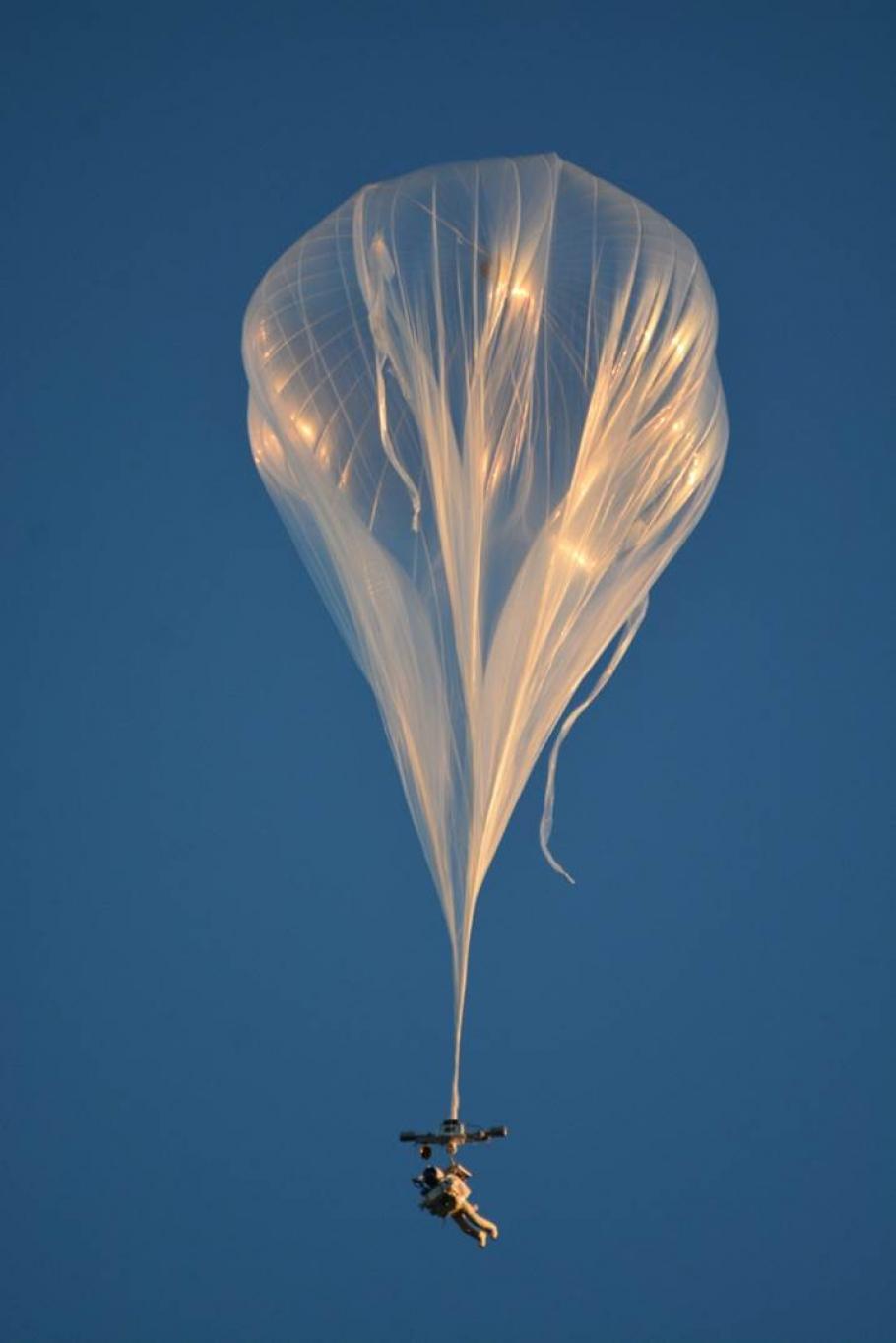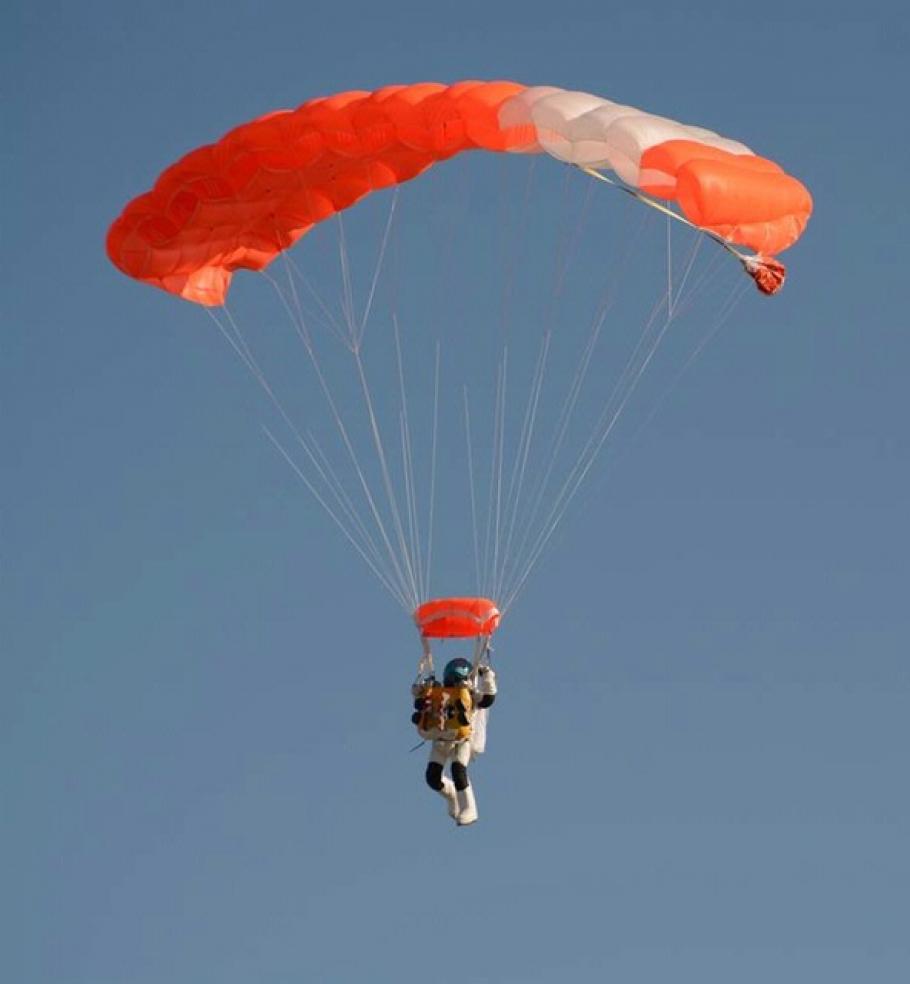On April 1, 2014, the National Air and Space Museum opened an exhibition featuring the pressurized Red Bull Stratos gondola that carried Felix Baumgartner to a record altitude of 39,045 meters (128,100 feet) over Roswell, New Mexico, and the pressure suit and parachute that protected him during the long fall back to Earth. Not long after, I had a visit from an old friend, balloonist Julian Nott, whose record-setting pressurized hot air balloon gondola was also coming into the Museum’s collection. One of the pioneers of modern ballooning, Julian has established 79 world ballooning records for altitude, distance, and time aloft during a long and extraordinary career. During our discussion of the Stratos project, I pointed out that the previous record for a high altitude parachute jump had stood from 1960 to 2012, and asked him if he thought Baumgartner’s record would last that long. With a patented Julian Nott smile, he responded that he did not think so. Now we know why. Launching at 7:00 am on October 24, 2014, Alan Eustace, senior vice president of Knowledge at Google, Inc., broke Baumgartner’s record with a parachute jump from and altitude of 41,419 meters (135,890 feet). The project began in December 2011, when Eustace contacted Taber MacCallum of the Paragon Space Development Corporation, a firm specializing in providing life support systems for use in extreme environments. The two put together a project team and devised a meticulously detailed plan for project StratEx, an effort enabling Eustace to parachute from someplace close to the top of the stratosphere. The project, which Eustace funded with no help from Google, moved quietly forward for over three years. Unlike the Red Bull effort, which was surrounded by a frenzy of publicity, the StratEx team remained under the media radar.
Operating from a launch site near Roswell, New Mexico, they conducted several test flights, first with mannequins, then with Eustace himself. The tests were life-savers. Eustace would have to deploy a small drogue chute at the outset to stabilize him during his long fall toward the thicker atmosphere. Attached to the center of the back of the suit on one test, the drogue chute sent the weighted mannequin into a rapid flat spin that would have killed Eustace. The attach point was repositioned. On the big day, Alan Eustace was carried aloft by a plastic balloon that stood almost 137 meters (450 feet) tall at launch and which expanded to a diameter of 94.8 meters (311 feet) at altitude. Climbing at about 304.8-meters (1,000-feet) a minute, it took 2.5 hours to reach an altitude of 41,419 meters (135,890 feet). Eustace wore an advanced pressure suit designed and produced by ILC Dover Industries, coupled with a life support system developed by Paragon. United Parachute Technologies provided the drogue, main, and reserve parachutes. ADE Aerospace Consulting supplied the medical team and required training, with Dr. Jonathan Clark serving as medical consultant. Julian Nott was the ballooning consultant and proposed a unique launch procedure. The Tata Institute of Fundamental Research, Hyderbad, India, produced all of the balloons used in the program. From the outset, the team could see little point in spending a lot of money to develop a sophisticated pressurized balloon cabin, only to have to lift such a heavy craft to altitude. Instead, Eustace made the flight dangling beneath the balloon via a beam structure known as the Balloon Equipment Module, protected only by his pressure suit, for a total weight of just 450 pounds. During a high altitude parachute jump in 1960, the shroud lines of the drogue chute had wrapped around Col. Joe Kittinger’s neck. The StratEx team solved that problem by the use of (3.66-meter; 12-foot-long) carbon fiber tube that held the lines away from the suit. Not long after dropping from the balloon, Eustace reached a record top speed of 1,321 kilometers per hour (822 mph, Mach 1.23). In addition, he set new world records for the highest jump (41,419 meters; 135,890 feet), and for distance of fall using a drogue chute (36,617 meters; 123,414 feet). He was safely back on the ground just 15 minutes after cutting loose from the balloon.
In the best National Air and Space Museum tradition, my colleague Cathleen Lewis, our curator of space and pressure suits, and I are negotiating to acquire this suit and related gear so that it can be preserved and displayed. The question now is, will the StratEx record stand longer than that of Red Bull Stratos? Only time will tell. It is certainly possible to design a balloon that will rise to a higher altitude. If I were a betting man….

